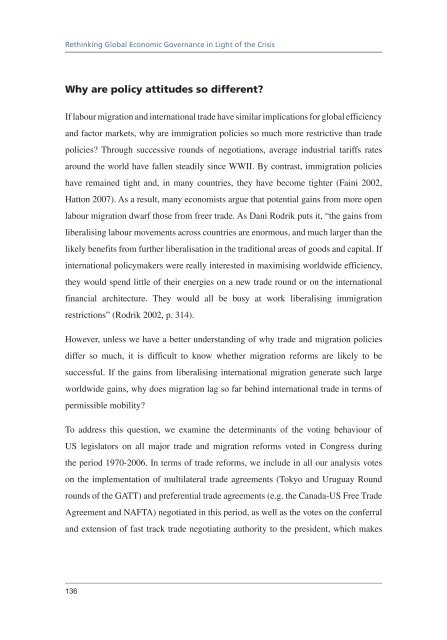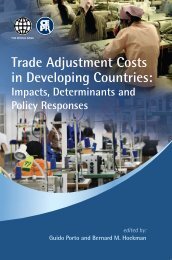Download PDF - Vox
Download PDF - Vox
Download PDF - Vox
- No tags were found...
You also want an ePaper? Increase the reach of your titles
YUMPU automatically turns print PDFs into web optimized ePapers that Google loves.
Rethinking Global Economic Governance in Light of the CrisisWhy are policy attitudes so different?If labour migration and international trade have similar implications for global efficiencyand factor markets, why are immigration policies so much more restrictive than tradepolicies? Through successive rounds of negotiations, average industrial tariffs ratesaround the world have fallen steadily since WWII. By contrast, immigration policieshave remained tight and, in many countries, they have become tighter (Faini 2002,Hatton 2007). As a result, many economists argue that potential gains from more openlabour migration dwarf those from freer trade. As Dani Rodrik puts it, “the gains fromliberalising labour movements across countries are enormous, and much larger than thelikely benefits from further liberalisation in the traditional areas of goods and capital. Ifinternational policymakers were really interested in maximising worldwide efficiency,they would spend little of their energies on a new trade round or on the internationalfinancial architecture. They would all be busy at work liberalising immigrationrestrictions” (Rodrik 2002, p. 314).However, unless we have a better understanding of why trade and migration policiesdiffer so much, it is difficult to know whether migration reforms are likely to besuccessful. If the gains from liberalising international migration generate such largeworldwide gains, why does migration lag so far behind international trade in terms ofpermissible mobility?To address this question, we examine the determinants of the voting behaviour ofUS legislators on all major trade and migration reforms voted in Congress duringthe period 1970-2006. In terms of trade reforms, we include in all our analysis voteson the implementation of multilateral trade agreements (Tokyo and Uruguay Roundrounds of the GATT) and preferential trade agreements (e.g. the Canada-US Free TradeAgreement and NAFTA) negotiated in this period, as well as the votes on the conferraland extension of fast track trade negotiating authority to the president, which makes136














